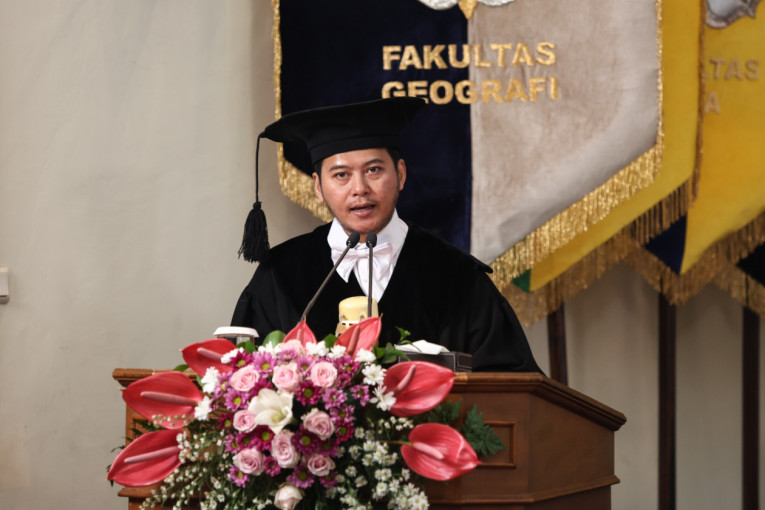
Professor Pramaditya Wicaksono has made history at UGM as the youngest full professor, achieving this milestone at the age of 35 years and 11 months.
On Jun. 1, 2023, he officially received the decree of appointment as full professor in remote sensing of coastal biodiversity at the Faculty of Geography, UGM. The formal inauguration ceremony occurred on Tuesday (Feb. 13) at the UGM Senate Hall.
Born in Semarang on Jul. 6, 1987, Professor Wicaksono broke the previous record held by Professor Agung Endro Nugroho, who achieved the position of full professor at 36 years and nine months.
Professor Wicaksono’s academic journey began with an undergraduate degree in Cartography and Remote Sensing from the Faculty of Geography, UGM 2008, completed in 3 years and 11 months. He then pursued his master’s studies in Geography at the same faculty from 2008 to 2010, supported by a Dikti Scholarship.
His academic pursuits culminated in a joint doctoral degree in Geography/Remote Sensing from UGM’s Faculty of Geography and ITT TH Koeln, Germany, 2015, funded by a CNRD (Centers for Natural Resources and Development) program scholarship from DAAD Germany.
In his inaugural address, Professor Wicaksono delved into the intricacies of mapping and monitoring seagrass beds using remote sensing techniques. These methods are deemed highly effective and efficient for comprehensive spatial and temporal analysis of seagrass ecosystems.
He highlighted Indonesia’s vast seagrass potential of 1,847,341 hectares, with only 294,464 hectares currently verified. Seagrass beds, crucial for economic and ecological functions, play a pivotal role in the implementation of the blue economy concept.
They support approximately 20% of the world’s major fisheries industry, valued at 200 million Euros annually, specifically in the Mediterranean alone. Moreover, seagrass beds are significant carbon sinks, exhibiting remarkable carbon absorption capabilities, over ten times more efficient than terrestrial ecosystems.
“Despite occupying just 0.1% of the ocean area, seagrass beds absorb approximately 18% of the total carbon absorbed by the earth’s oceans,” Professor Wicaksono elaborated.
Sustainable management of seagrass ecosystems is indispensable for realizing the blue economy concept and advancing global Sustainable Development Goals (SDGs).
Despite their significance, seagrass beds receive minimal protection, with global degradation reaching 58% since 1980, equivalent to losing a football field-sized area every 30 minutes, according to UNEP data in 2020. Hence, comprehensive data and information on seagrass ecosystems are pivotal for coastal area planning and management.
“Understanding their spatial and temporal distribution patterns is crucial to effectively manage seagrass beds and leverage their role as nature-based solutions for climate change adaptation and mitigation. Remote sensing technology offers the most efficient and effective means to achieve this,” the young professor emphasized.
He mentioned that an optimal remote sensing model for mapping seagrass ecosystem biodiversity needs to consider the temporal variations of the mapped seagrass ecosystems. Each region’s temporal variations in seagrass ecosystems are unique, depending on species composition and habitat conditions.
Therefore, mapping processes to understand blue carbon dynamics in seagrass beds should be conducted annually, preferably monthly, bimonthly, or at least seasonally.
Furthermore, he said that analyzing changes in seagrass cover cannot be done if the data or maps used for analysis are obtained from different months or seasons. This could lead to inaccurate conclusions and potentially affect decision-making and relevant management strategies. Therefore, consistency in data collection and mapping at appropriate time intervals is required.
Additionally, to achieve high accuracy and obtain seagrass ecosystem biodiversity maps that represent actual conditions on the earth’s surface, a classification scheme for mapping needs to be developed considering the resolution and capabilities of remote sensing data used.
Author: Ika
Photographer: Donnie

